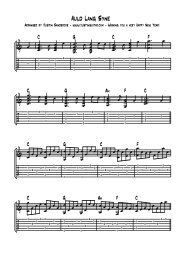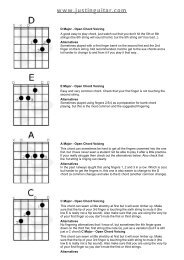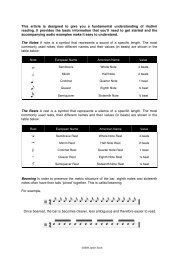Walking The Bass (Jazz Blues 1) Translation of - Justinguitar
Walking The Bass (Jazz Blues 1) Translation of - Justinguitar
Walking The Bass (Jazz Blues 1) Translation of - Justinguitar
You also want an ePaper? Increase the reach of your titles
YUMPU automatically turns print PDFs into web optimized ePapers that Google loves.
Language: English to Italian<br />
Translated by: Adriano Grimolizzi<br />
JA-203 / JA-32 - <strong>Walking</strong> <strong>The</strong> <strong>Bass</strong> (<strong>Jazz</strong> <strong>Blues</strong> 1)<br />
<strong>Translation</strong> <strong>of</strong> the video lesson<br />
Hi, how you doing? Justin here again. Another request -- a special request lesson -- this<br />
time we're going to look at a jazz blues with a walking bass. You almost certainly want<br />
to download the PDF for this one because it's going to be quite complicated if you don't<br />
have that to hand, so you might want to go and download that right now from<br />
www.justinguitar.com. So get that downloaded, get that in front <strong>of</strong> you and then we'll<br />
start going -- or you should start going through -- so maybe hit that pause button just<br />
now.<br />
Salve come va? Qui di nuovo Justin. Un altra richiesta –- una speciale lezione su<br />
richiesta – questa volta affronteremo un jazz blues con un <strong>Walking</strong> <strong>Bass</strong> *. Vorrete quasi<br />
certamente scaricarvi il pdf per questa lezione, perchè sarà molto complicata se non<br />
l'avrete al fianco, quindi potreste andare a scaricarlo immediatamente da<br />
www.justinguitar.com. Scaricatelo, mettetevelo di fronte e poi cominceremo – o<br />
potreste cominciare immediatamente --- quindi potete mettete in pausa adesso.<br />
Okay, so we're going to do this jazz blues in Bb, there's fingering written on the page,<br />
I'll just first <strong>of</strong> all play it once the way through so you can see what's going on, and then<br />
I'll go through and explain the little bits to you. So this is what it sounds like . . .<br />
Okay, faremo questo jazz blues in Si Bemolle (Bb), la diteggiatura è scritta sulla pagina,<br />
prima di tutto lo suonerò una volta per farvi capire cosa succederà, e poi andrò a<br />
spiegarvi i piccoli pezzi. Suona così . . .<br />
Now, when you're playing this kind <strong>of</strong> walking-bass blues, it's really kind <strong>of</strong> improvisingbased,<br />
so what I've got here is kind <strong>of</strong> an example; I have to really concentrate doing<br />
this actually to play it the same as the piece <strong>of</strong> paper because I just want to make it all<br />
up as I go along. <strong>The</strong> idea would be to look at the techniques and to try and look at<br />
each different lick and the way each chord joins to the next one, and then start to play<br />
about with it yourself. One <strong>of</strong> the most important things that we're talking or that we do<br />
in this is called "chromatic leading tones", which means it's 1 semitone above or below<br />
the root note, and that chromatic leading tone appears on beat 4 <strong>of</strong> the previous bar, so<br />
for instance going from Bb here . . . you've got here the chromatic leading tone E, going<br />
to the Eb, but we could use the E a semitone above and go . . . you can use chromatic<br />
leading tones in both directions, so that's one way that you should start experimenting<br />
with this yourself straight away. I think we'll go for a quick close-up <strong>of</strong> the hand and I'll<br />
play through it again just so you can get a good view <strong>of</strong> the fingering <strong>of</strong> the left hand.
<strong>The</strong> right hand all <strong>of</strong> the way through, the thumb is playing the bass every time, and the<br />
fingers 1 and 2 -- sometimes 1 2 and 3 -- are playing the chord. <strong>The</strong> most important<br />
thing to remember when doing this sort <strong>of</strong> stuff is keeping the bass consistent. You can<br />
fluff the chord or not hit a chord properly and you won't really notice, but if you kind <strong>of</strong><br />
lose time with the bass it'll sound a bit weird. So that's the two things to remember,<br />
let's go for a quick close-up <strong>of</strong> the left hand so you can check what's going on, but like I<br />
said the fingering's written on the page so you'll want to check that out too. Okay Jedi,<br />
left hand.<br />
Ora, quando suonate quest tipo di walking blues, è veramente basato<br />
sull'imporvvisazione, quindi quello che vi darò qui è una specie di esempio; ho dovuto<br />
concetrarmi nel farlo identico al pezzo di carta perchè voglio solamente inventare sul<br />
momento. L'idea sarebbe di osservare la tecnica e provare a guardare ad ogni diverso<br />
fraseggio e il modo in cui ogni accordo si unisce al successivo, e poi comincirare a<br />
giocarci da soli. Una delle cose piu importanti di cui parleremo e che faremo sono<br />
chiamate note sensibili, che vuol dire che sono di un semitono più alto o piu basso della<br />
tonica, e che questa sensibile compare sul quarto battito della battuta precedente. Per<br />
esempio passando dal Si Bemolle qui . . . avete la sensibile Mi che passa a Mi Bemolle,<br />
ma potremmo usare il Mi un semitono più alto . . . potete usare le sensibili in entrambe<br />
le direzioni, ed è un modo con cui potreste cominciare a sperimentare subito. Credo<br />
faremo un veloce primo piano della mano e lo suonerò di nuovo per farvi avere una<br />
buona veduta della diteggiatura della mano sinistra. Per quanto riguarda la mano<br />
destra, il pollice suona il basso ogni volta, e le dita 1,2, a volte 1,2 e 3, suonano<br />
l'accordo. La cosa piu importante da ricordarsi quando si fa quest è mantenere il baso<br />
consistente. Potete mancare o non suonare bene un accordo e non ve ne accorgerete<br />
tanto, mase perderete il tempo col basso suonerà un po strano. Sono queste le due cose<br />
che dovrete ricordarvi, facciamo un primo piano sulla mano sinistra in modo che<br />
possiate controllare cosa succede, ma come ho detto prima, la diteggiatura è scritta<br />
sulla pagina, quindi vorrete controllare anche quella. Ok Jedi, mano sinistra.<br />
Okay, so, checking out the fingering for the first Bb7, remember even though that's a<br />
proper Bb7 because we're choosing what notes we play we only have to put this much<br />
down, so you'd have this . . . bass . . . chord . . . bass . . . bass. Stretch back . . . then<br />
we've got Eb7 like this . . . first finger . . . little finger's reaching up, then we've got up<br />
here . . . now this is the same chord -- it's that first one we played, just with different<br />
fingers . . . walking the bass back . . . and back forward . . . back to the same chord<br />
with that original fingering . . . here we go, Eb7 . . . there's some nice movements just<br />
there . . . now we chromatic walk up to the eighth (so the Bb chord) . . . moving<br />
chromatically down . . . to the Cm7 . . . B . . . you want to pay special attention to this<br />
little pattern we've got here with this fingering, it's a really nice way <strong>of</strong> . . . you can see<br />
that the 3rd finger moves up and the rest <strong>of</strong> the fingers stay the same . . . it's really<br />
good if you're ever going to play rhythm changes, you've got all this . . . so you can see<br />
you could use that one little shape quite a lot. So hopefully you can see the fingering<br />
nice and clear there.<br />
Okay, allora, vediamo la diteggiatura del primo Si Bemolle 7, ricordate che anche<br />
essendo un vero Si Bemolle 7, siccome scegliamo quali note suonare dobbiamo<br />
solamente usare queste dita, quindi avremmo queste … basso. . . accordo … basso …<br />
basso. Andiamo indietro . . . poi abbioamo il Mi Bemolle 7 così . . . primo dito … il<br />
mignolo lo raggiunge. . .poi abbiamo, questo è lo stesso accordo – il primo che abbiamo<br />
suonato, ma con una diteggiatura diversa. Portiamo il basso avanti, . . .e indietro . . .<br />
fino alla stessa corda con la diteggiatura originale. . . eccoci qui, Mi Bemolle 7 . . . è
stato un bel movimento . . . ora camminiamo cromaticamente fino all'ottava( quindi il Si<br />
Bemolle) . . . ci muoviamo cromaticamente in basso . . . al Do Minore 7 (Cm7) . . . Si. .<br />
. Vorreste fare particolare attenzione al piccolo pattern che abbiamo qui con la<br />
diteggiatura, è un modo davvero carino di... potete vedere che il terzo dito si muove in<br />
su e il resto delle dita rimane lo stesso. . . è davvero buono se volrrete mai suonare<br />
cambi ritmici , avere tutto quest . . . quindi potete vedere che useremo questa forma un<br />
bel po'. Spero possiate vedere la diteggiatura chiaramente.<br />
Okay so I hope that was nice and clear, that you've got the fingering sorted out for that<br />
jazz blues walking bass. Like I said the main thing that you want to try and get is the<br />
patterns, and it's definitely a good idea to try and improvise and learn to do that as<br />
soon as you can. On the website there's also a second jazz blues walking bass, which is<br />
the same chords but with a slightly different pattern, so if you've checked out walking<br />
bass one which is the one we've just done, check out the number 2 for yourself, and<br />
then see if you can combine them and start to improvise within them a little bit, that'd<br />
definitely be the way to go.<br />
Okay spero sia stato chiaro, avete la diteggiatura per il jazz blues walking bass. Come<br />
ho detto la cosa principale da cercare di capire sono I pattern, ed'è sicuramente una<br />
buona idea cercare di improvvisare e imparare a farlo il prima possibile. Sul sito c'è<br />
anche un secondo jazz blues walking bass, con gli stessi accordi, ma con un pattern<br />
leggermente diverso , quindi se avete visto il primo che è quello che abbiamo appena<br />
fatto, provate da soli il numero 2, e vedete se riuscite a combinarli e riuscire a<br />
improvvisare un po', che è sicuramente la miglior cosa da fare.<br />
<strong>Walking</strong> bass is a great skill to get down. If you're really into this jazz thing leave some<br />
comments and requests for more, because I'm still a bit not sure what to put up on<br />
YouTube because I could do all sorts <strong>of</strong> stuff and I'm not sure what all you guys want to<br />
see! So let me know and I'll chuck it up there. Okay, have a nice one, I wish you all the<br />
best and a happy new year, see you soon, bye!<br />
Il <strong>Walking</strong> <strong>Bass</strong> è una gran cosa da saper fare. Se queste lezioni di jazz vi piaciono<br />
veramente lasciate un cammento e qualche richiesta, perchè non sono ancora sicuro<br />
cosa mettere su YouTube perchè potrei fare ogni tipo di cosa e non sono sicura cosa<br />
volete vedere voi! Quindi fatemi sapere e ve lo metterò quì. Okay, divertitevi, vi auguro<br />
tanta felicità e un felice anno nuovo, ciao!<br />
* NDT <strong>Walking</strong> bass può essere tradotto più o meno come basso che cammina, portare<br />
a spasso il basso, come in “walking the dog”, portare a spasso il cane.






